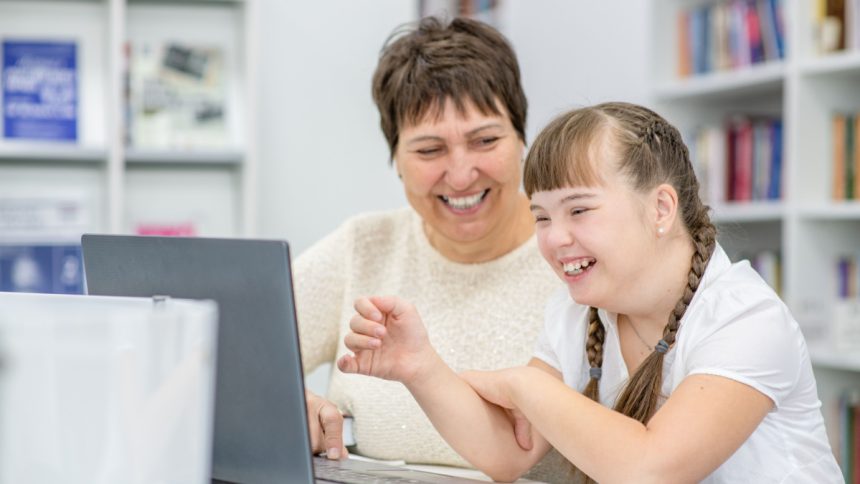If we want to know how we can take advantage of smart-phones, tablets, and digital tools to support the learning needs of students with disabilities, a good place to start is examining how teachers already put them to work, in school and beyond. With mobile bans rolling out in many jurisdictions, knowing how these devices are used in real teaching contexts is an important part of adjusting appropriately to the bans.
How are mobile devices being used to support students’ learning in specialist schools and in specialist support units within mainstream schools?
This is the question a team of researchers from University of Technology Sydney (UTS) set out to answer, with the help of survey responses from 126 teachers from across the country.
Their findings provide a detailed understanding of teachers’ current digital approaches. Teachers are actively using mobile devices to enhance their students’ learning – especially by offering them more control over their own learning – but untapped potential remains.
Developing agency
“There is a lot of rhetoric about the ways mobile technology can change learning for the better, but the reality often falls short,” says Professor Paul Burke.
Mirroring this gap between promise and reality are the gaps apparent in the research. One of the most under-researched areas is how mobile technology is leveraged in specialist disability education.
“Research has mostly focused on how mainstream schoolteachers support students’ learning with mobile devices,” researcher Dr Kirsty Young says. “Much less research has been done in special education settings, and what has been done tends to focus on mobile technologies as assistive devices or has a narrow focus on specific skill development.”
“Our study was a response to the fact that not enough attention has been given to examining how mobile technology is used in a real teaching context. Our idea was to shed some light on the evolving relationship between teachers, students, and technologies,” Professor Burke says.
Key findings:
· A survey of 126 special education teachers shows they are actively designing a range of tasks for mobile digital learning.
· Teachers rated personalisation – student control over when and where they perform the tasks, and the tasks’ content and sequence – as their most valued aspect of mobile learning.
· Authenticity – real-world relevance to students – while less highly rated, was an important part of some tasks.
· Twenty-five (25) per cent of teachers created tasks that could be pursued at home and in the classroom, while another twenty-two (22) per cent created tasks that involved a range of locations.
· Participating specialist disability teachers performed more seamless learning across multiple sites than previous studies of mainstream education.
· Other areas that could be enhanced by mobile digital learning, like greater collaboration and communication, were not as strongly emphasised.
· Teachers rated their students overall learning and enjoyment highly for the mobile learning tasks.
· Sixty-three (63) per cent of tasks involved a tablet such as an iPad.
· Fifty-one (51) per cent of tasks involved students working across two or more apps.
“This is promising evidence about how special education teachers are embracing complex mobile learning tasks with their students,” says Dr Young. “The way these enhance student agency and control was clear.”
The power of personalisation
To uncover the practices of special education teachers, Dr Kirsty Young and Professor Matthew Kearney consulted with other experts in the special education field to adapt an influential approach known as the iPAC framework, which Professors Kearney and Burke have been involved in developing and verifying.
This framework identifies three areas of learning in which mobile technology can have a distinct impact: personalisation, authenticity, and collaboration.
“Personalisation is widely recognised as a key feature of mobile learning,” says Professor Burke. “In well-designed mobile learning activities, students have enhanced agency, with greater control over the place, pace, and time they learn, and potentially the learning content as well. Furthermore, students’ learning experiences can be customised through their device, with individually tailored settings and feedback.”
“In our study, teachers rated student agency very highly, it was the value that most strongly motivated their use of learning tasks with mobile technology, and guided the way they designed them,” Prof Burke says.
“The importance of agency for students with disability is often overlooked, but this study shows that teachers tend to understand just how important it is. They really emphasised students’ control of the pace of their digital learning tasks, and that is completely in keeping with what we have seen in studies of mainstream teachers.”
“Perhaps one key potential of digital learning that of authentic learning. We found that teachers did not rate authenticity as highly as personalisation,” Professor Burke says. “This is similar to our previous findings in mainstream schools.”
“Authenticity means real-world relevance and personal meaning for learners, and also doing things like a practitioner would. Mobile learning can support this, because it can take place in all kinds of rich, relevant contexts. Because the setting is in both the physical world and the virtual world of the device, it can happen at places and times that are suggested by the topic, whether that is history at a museum, or geography through a train journey. ”
Real-world learning
“There is an opportunity here to integrate vital life-skills into education, which can be seen in some of the tasks teachers are designing” says Dr Young. In the study, one teacher reported on a task that focused on English and literacy, while also developing students’ functional living skills around independent travel. The students used transport apps, text messaging, and camera apps on their own iPads in a range of school and non-school settings.
The teacher reported that, “Students use text for safety purposes, bus, and train apps to check timetables, and the camera to send staff a photo if they are unsure where they are. I found that their independence and confidence clearly improved.”
“The most common setting for tasks is still the formal classroom,” Dr Young says, “but we did see that specialist teachers are designing tasks that involve across multiple settings, especially a combination of classroom and home.”
“While most teachers in this study set tasks in the classroom or at home, there was encouraging evidence of teachers creating seamless learning across multiple different settings. Specialist teachers are making use of the fact that mobile digital learning is, well… mobile.” say Prof Burke. “This is an interesting contrast to our previous findings among mainstream teachers; comparing the two studies, specialist teachers look to more actively engage this seamless learning across different places.”
Those teachers who built out-of-classroom settings into learning designs also reported that these tasks involved more personalised and authentic learning experiences.
“There is so much potential for mobile learning to support the generalisation of skills in and beyond the classroom, and these findings help to illustrate that,” Dr Young says.
The researchers found that some teachers designed tasks for students’ engagement in activities related to everyday life, such as a physical education and health task that saw Kindergarten to Year two students take photos of themselves cooking and gardening, which they would then print and paste into scrapbooks, so they could add labels and make comments, and describe the plants and ingredients they used.
However, there was less emphasis on designing tasks for places or times suggested by the topic or requiring students to work in realistic, discipline-specific ways.
One of the exceptions was a classroom-based activity that taught maths and numeracy, while also developing students’ functional living skills.
The teacher offered a choice of four self-paced tasks using school-owned tablets and a 3D design app. The tasks ranged from simpler and constrained, to more open-ended and complex. In the more sophisticated fourth task, students could tackle the design of a three-bedroom home, with one bathroom and an outdoor entertainment area, and with no restrictions on features. The “a 3D version of what they had created. This made a huge difference to their understanding of what a plan was, and what it would look like in real life”.
Leadership needed
“There could be more opportunities, in the future, to exploit a wider range of the distinctive aspects of mobile learning, especially tasks allowing students with disabilities to work with mobile devices to experience aspects of collaborative and authentic learning. Tasks that take full advantage of the growing diversity of physical and virtual learning spaces may also be useful to consider.”
“Research suggests that there has been a lack of concerted leadership in schools, which would be needed to convert mobile technology from a potential distraction belonging to the ‘outside world’ to being a dynamic part of classroom education,” says Professor Burke.
“Our study also showed that those teachers who were more experienced in mobile learning were getting the most complete use of the technology in the tasks they designed, in terms of personalisation, agency, collaboration, and overall learning. This did not correlate with teaching experience in general. These results highlight a need for professional development around special education teachers’ confidence and proficiency with mobile learning, regardless of overall teaching experience.”








